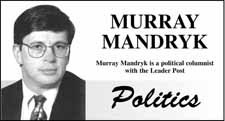If it was Premier Brad Wall's fondest wish to unite the province, he just might have achieved it.
Of course, he's had a big helping hand from NDP leader Dwain Lingenfelter ... although perhaps not in the way that Lingenfelter would have hoped to contribute.
The recent Praxis Analytics poll conducted for the Regina Leader-Post and Saskatoon StarPhoenix shows a remarkable 63.4 per cent of Saskatchewan voters indicating they would vote for Wall's Sask. Party compared with 26.1 per cent one per cent that would support Lingenfelter's NDP. For Wall, this sampling of 800 people taken in the last week of August and first week of this month is about as good as it gets in this politically divided province.
And while Sask. Party officials are downplaying the numbers (likely, because such an overwhelming majority isn't great for getting out the vote in November), these numbers are only slightly higher than past results. For example, a late 2009 poll conducted for the Leader-Post indicated the government was at 59.5 per cent. The difference between that poll two years ago and this one is close to the plus or minus 3.5-per-cent margin of error of such scientific samplings.
Of course, some would argue that such overwhelming numbers - which would translate into between 47 and 51 Sask. Party seats in 58-seat assembly, some analysts estimate - wouldn't be great for a province that relies on solid opposition scrutiny for good government. That may be true.
But if there is one upside in all this, it's that no one can suggest there is a division between urban NDP and rural Sask. Party anymore. Wall's popularity and Lingenfelter's unpopularity has changed all that.
For example, of the 63.4 per cent that said they would likely vote for Wall and the Sask. Party, the breakdown is as follows: farms and acreage, 70.1 per cent; towns of 5,000 and under, 64.4 per cent; cities between 5,000 and 20,000, 67.4 per cent, and; cities more than 20,000, 56.3 per cent.
Conversely, NDP-Lingenfelter support is as follows: farms, 25.6 per cent; towns, 21.5 per cent; smaller cities 19.6 per cent, and; Regina and Saskatoon, 56.3 per cent.
In fact, Wall's support was remarkably consistent everywhere but the far north that remains overwhelming New Democrat: west central, 67.5 per cent; central, 80 per cent, east central, 64.7 per cent; southwest, 66.7 per cent; Regina, 62 per cent, and; Saskatoon, 56.3 per cent.
The urban numbers - especially Regina's overwhelming Wall support - were particular surprising and pollster always warn about the accuracy of such smaller sub-samplings. But it does outline a provincewide trend that's consistent.
When people were asked which party they definitely wouldn't vote for, the results for the NDP were as follows: farms, 45.3 per cent; towns 29 per cent; smaller cities, 21.8 per cent; Saskatoon, 24.2 per cent; Regina, 32.4 per cent; Moose Jaw, 20 per cent; southwest 31.6, per cent; east central, 32.3 per cent, central, 40.9 per cent, and; west central, 37.7 per cent.
Conversely, asked who they wouldn't vote, the results for the Sask. Party were: farms, 9.4 per cent; towns, 5.5 per cent; small cities, 20 per cent; Regina, 16.7 per cent; southwest, 7.9 per cent; east central, 19.4 per cent; central, 9.1 per cent, and: west central, 8.7 per cent.
Obviously, there will always be some variance from urban to rural and region-to-region. But there is not as much as their used to be.
In fact, what was remarkable about the poll was the consistency in the Sask. Party numbers across the board. Asked to rate the job the government was doing on a scale of one-to-five (five, being best), the Sask. Party received: 3.63 on the farms; 3.53 in the towns; 3.27 in the smaller cities, and; 3.4 in the large cities.
The poll indicates a rather unusual thing for Saskatchewan - relative unity behind one party.
Murray Mandryk has been covering provincial politics for over 15 years.




